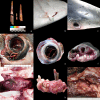Pathology of stranded blue sharks (Prionace glauca) impaled by swordfish (Xiphias gladius)
- PMID: 40796598
- PMCID: PMC12344147
- DOI: 10.1038/s41598-025-13617-9
Pathology of stranded blue sharks (Prionace glauca) impaled by swordfish (Xiphias gladius)
Abstract
This article describes the pathological findings of ten blue sharks (Prionace glauca) stranded after fatal interactions with swordfish (Xiphias gladius) in the western Mediterranean. Multiple rostral fragments were found using diagnostic imaging techniques (X-rays and Computed Axial Tomography) or during necropsy, associated with severe injuries in all animals. The most affected organ was the encephalon, showing meningeal and brain hemorrhages, encephalomalacia, and acute encephalitis, followed by the eyes, which exhibited hemorrhage and acute panophthalmitis. Other commonly observed lesions included hepatic emaciation, necrotic hemorrhagic ulcers in the spiral valve, and glomerulonephritis. Interestingly, in some cases where multiple rostral fragments were observed, some were surrounded by fibrous connective tissue, indicating non-fatal previous interactions. This study suggests that swordfish interactions with blue sharks may be underestimated and reveals the importance of using diagnostic methods such as CT scans to effectively assess the presence of rostral fragments.
Keywords: Agonistic behavior; Blue sharks; CT scan; Histology; Pathology; Rostrum; Swordfish.
© 2025. The Author(s).
Conflict of interest statement
Declarations. Competing interests: The authors declare no competing interests.
Figures





References
-
- Smith, J. Pugnacity of Marlins and swordfish. Nature178, (1956).
-
- Ellis, R. Armed and angerous. in Swordfish: A Biography of the Ocean Gladiator 61–90 (University of Chicago Press, Chicago, (2013).
-
- Romeo, T., Amendola, G., Canese, S., Andaloro, F. & Battaglia, P. Recent records of swordfish attacks on harpoon vessels in the Sicilian waters (Mediterranean Sea). Acta Adriat (Online). 58, 147–156 (2017).
-
- Penadés-Suay, J., García-Salinas, P., Tomás, J. & Aznar, F. J. Aggressive interactions between juvenile swordfishes and blue sharks in the Western mediterranean: a widespread phenomenon? Medit Mar. Sci.20, 314–319 (2019).
-
- Machida, S. A swordfish sword found from a North Pacific Sei Whale. Sci. Rep. Whales Res. Inst.22, 163–164 (1970).
MeSH terms
Grants and funding
LinkOut - more resources
Full Text Sources

